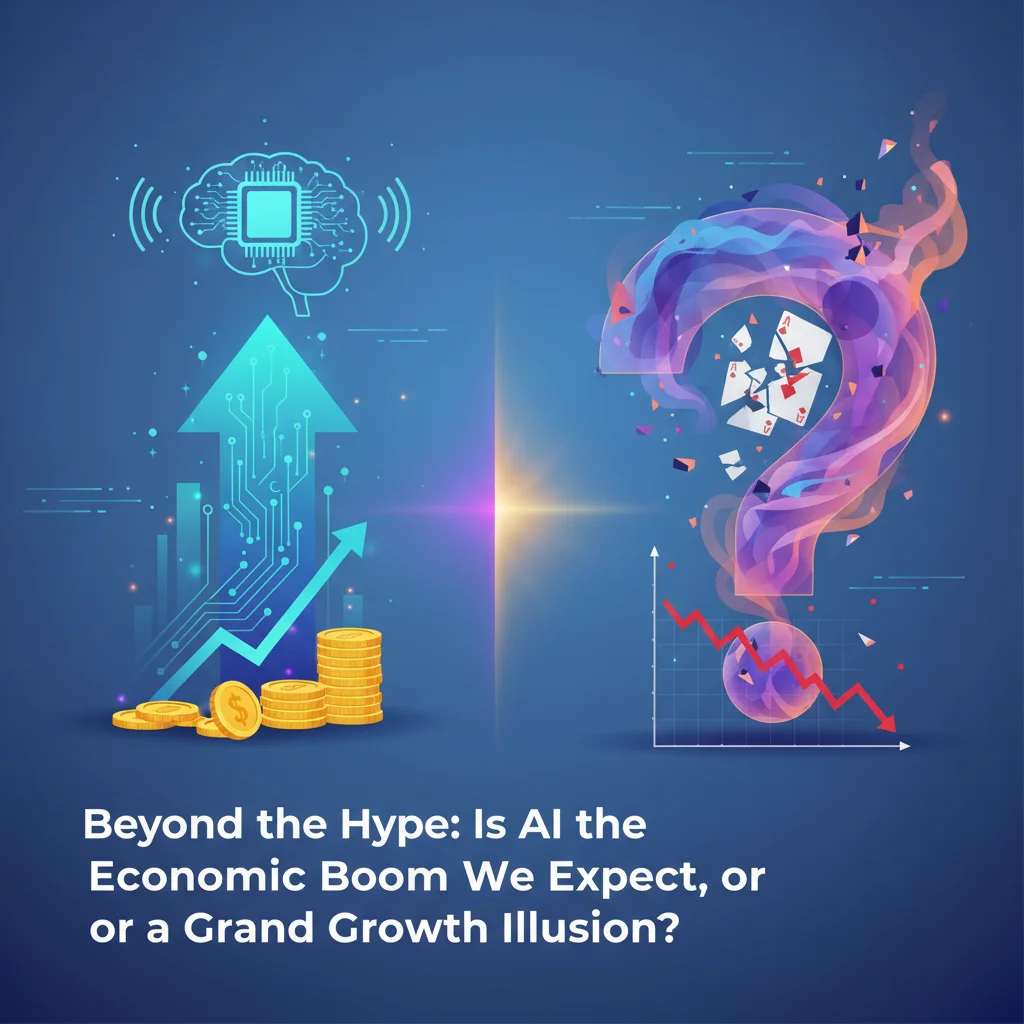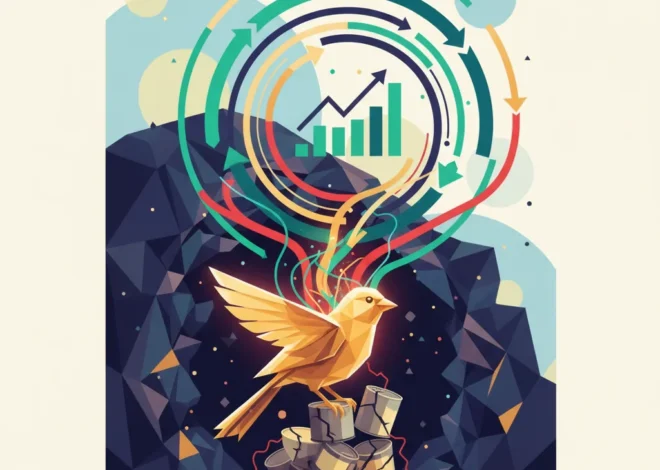
Beyond the Hype: Is AI the Economic Boom We Expect, or a Grand Growth Illusion?
The financial world is electric with the promise of Artificial Intelligence. Stock prices for chipmakers like Nvidia have soared to astronomical heights, venture capital is flooding into AI startups, and every CEO seems to be touting their “AI strategy.” The dominant narrative is clear: we are on the cusp of a technological revolution that will unlock unprecedented levels of productivity and trigger a massive economic boom. The stock market seems to agree, pricing in decades of exponential growth.
But what if this narrative is too simple? What if the direct line from AI adoption to GDP growth is more of a winding, uncertain path than a superhighway? This is the critical question raised in a recent letter to the Financial Times by Bernard H Casey of Social Economic Research, who points towards a potential “growth illusion.” This isn’t a dismissal of AI’s power but a crucial call for nuance and historical perspective—a perspective that every investor, business leader, and finance professional needs to consider.
This article delves beyond the hype to critically examine the economic promises of AI. We will explore historical parallels, dissect the mechanisms of productivity, and offer a balanced framework for understanding one of the most significant economic questions of our time.
The Bull Case: A New Engine for the Global Economy
First, it’s essential to understand why the excitement is so palpable. The arguments for an AI-driven economic renaissance are compelling. Proponents believe AI, particularly Generative AI, will act as a “general-purpose technology,” much like electricity or the internet, fundamentally reshaping every corner of the economy.
The potential gains are staggering. Consulting firms have been eager to quantify this revolution. For example, some analyses suggest that generative AI could add the equivalent of $2.6 trillion to $4.4 trillion annually to the global economy. This value is expected to come from several areas:
- Hyper-Productivity: Automating routine tasks, from writing code and drafting legal documents to customer service inquiries, freeing up human workers to focus on higher-value strategic thinking.
- Innovation Acceleration: Speeding up R&D cycles in fields like drug discovery, material science, and engineering, leading to faster breakthroughs.
- New Markets and Services: Creating entirely new business models and services that are currently unimaginable, from hyper-personalized financial technology (fintech) to AI-native entertainment.
For those in finance and investing, this translates into a powerful narrative that has fueled the stock market. The logic is that companies leveraging AI will see wider profit margins, faster growth, and a stronger competitive moat, justifying sky-high valuations.
The EU's New Global Rulebook: A Bold Move for Sustainability or a Dangerous Overreach?
Echoes of the Past: The Productivity Paradox Revisited
However, history urges caution. The belief that a powerful new technology will automatically translate into measurable economic growth has been tested before—and the results were not what economists expected. This brings us to the core of the “growth illusion” argument: the specter of the productivity paradox.
In 1987, Nobel laureate economist Robert Solow famously quipped, “You can see the computer age everywhere but in the productivity statistics.” (source). Throughout the 1970s and 1980s, businesses invested heavily in computers, yet national productivity growth remained sluggish. Why?
Economists later identified several reasons for this lag, all of which offer powerful lessons for the AI era:
- Implementation and Integration Lag: A new technology’s potential isn’t unlocked by simply buying it. It requires redesigning business processes, retraining workforces, and changing organizational culture. This takes years, if not decades.
- Measurement Issues: Traditional economic metrics like GDP may not fully capture the benefits of new technology. How do you measure the value of increased convenience, better quality, or free information services?
- Misdirected Investment: Many early investments were focused on automating existing tasks rather than creating new value. The real gains came later when companies started building entirely new business models around the technology (e.g., Amazon, Google).
The parallel to AI is striking. Are we currently in a phase where businesses are using AI for marginal efficiency gains rather than fundamental transformation? Is the current boom in the stock market a reflection of future potential, or is it front-running a revolution that may take much longer to materialize in the broader economy?
Efficiency vs. Growth: Deconstructing AI’s True Economic Impact
The heart of the “growth illusion” debate lies in the distinction between efficiency and genuine economic growth. While related, they are not the same. Efficiency is about doing the same things with fewer resources (cost-cutting). Growth is about creating new goods, new services, and new markets (value creation).
A business using AI to handle 50% of its customer service emails has become more efficient. But if it doesn’t use those freed-up resources to innovate or expand, the net effect on the macro-economy might be minimal or even deflationary. The real, sustained boom will only come from the second-order effects: when companies use AI to invent things that were previously impossible.
To illustrate this crucial difference, consider the potential impacts across different sectors:
| Sector / Function | Efficiency Gain (Cost-Cutting Focus) | New Value Creation (Growth-Driving Focus) |
|---|---|---|
| Banking & Finance | Automating fraud detection, credit scoring, and compliance reporting. Reducing back-office headcount. | Creating hyper-personalized financial products, AI-driven robo-advisors for new market segments, and dynamic risk models for novel assets. |
| Software Development | Using AI co-pilots to write boilerplate code faster, accelerating testing cycles. | Building entirely new categories of “AI-native” applications that can reason, adapt, and interact in complex ways. |
| Healthcare | Automating administrative tasks, transcribing doctor’s notes, and optimizing hospital scheduling. | Accelerating drug discovery through protein folding simulation, providing AI-powered diagnostic tools for early disease detection, and enabling personalized medicine at scale. |
| Retail | Optimizing supply chains and inventory management, automating warehouse logistics. | Creating immersive, AI-driven shopping experiences; dynamic, real-time pricing; and hyper-personalized product recommendation engines that create new demand. |
As the table shows, the initial, easier-to-capture benefits are in efficiency. The harder, but far more valuable, benefits are in new value creation. Investors and business leaders must ask: is a company’s AI strategy just about cutting costs, or is it about inventing the future of its industry?
Beyond the Ballot Box: How State Elections Shape Investment Strategy and the National Economy
An Investor’s Guide to Navigating the AI Hype Cycle
For those involved in investing and trading, this distinction is paramount. The current market dynamics bear some resemblance to previous technology bubbles, most notably the dot-com boom of the late 1990s. During that period, any company with “.com” in its name saw its stock soar, regardless of its business model or profitability. The bubble eventually burst, wiping out trillions in market value, but from the ashes rose the giants that define our modern economy, like Amazon and Google (source).
We may be in a similar phase with AI. The initial beneficiaries are the “picks and shovels” companies—those building the foundational infrastructure like GPUs (Nvidia), cloud computing (Amazon, Microsoft, Google), and core models (OpenAI). This is a logical first step, but the long-term, transformative value will be captured by the companies that effectively *apply* this technology.
Here are key considerations for navigating this landscape:
- Look Beyond the Hype: Scrutinize a company’s AI claims. Is it a press release talking point or a core driver of their business model? Ask for metrics: how is AI improving margins, creating new revenue streams, or increasing customer retention?
- Differentiate Infrastructure from Application: Investing in the “picks and shovels” is a valid strategy, but it’s a concentrated bet on the continuation of the arms race. Investing in application-layer companies (in sectors from fintech to healthcare) is a bet on who will use the tools most effectively. This is where deep domain expertise matters.
- Focus on Real Value Creation: Revisit the table above. Is the company’s strategy focused on defense (cost-cutting) or offense (innovation)? The biggest long-term winners will be those on the offense. In the world of financial technology, this means looking for firms not just automating banking tasks but fundamentally reimagining how trading, lending, and payments work.
- Be Wary of Valuation: The market is pricing in perfection. Acknowledge the immense uncertainty in the timeline and magnitude of AI’s economic impact. A healthy dose of skepticism is a valuable asset when enthusiasm is at its peak.
Conclusion: From Illusion to Reality
The promise of an AI-powered future is not an illusion. The technology is real, and its capabilities are expanding at a breathtaking pace. The “growth illusion,” as Bernard H Casey’s letter suggests, is the mistaken belief that this technological marvel will translate into immediate, frictionless, and universally distributed economic growth.
The reality is that the path from technological potential to economic reality is long and complex. It requires not just innovation in the lab but also transformation in the boardroom, on the factory floor, and in our public institutions. It will create both winners and losers, and its benefits may not be neatly captured by our current economic indicators for many years to come.
For investors, executives, and policymakers, the challenge is to see through the hype. We must move beyond the simple narrative of an inevitable boom and engage with the harder questions of implementation, value creation, and societal adaptation. The greatest rewards will not go to those who simply buy into the AI story, but to those who understand its nuances and build resilient, innovative strategies for the complex reality that lies ahead.
A New Era for Wall Street: Analyzing the Economic Ripple Effects of NYC's Political Shake-Up


